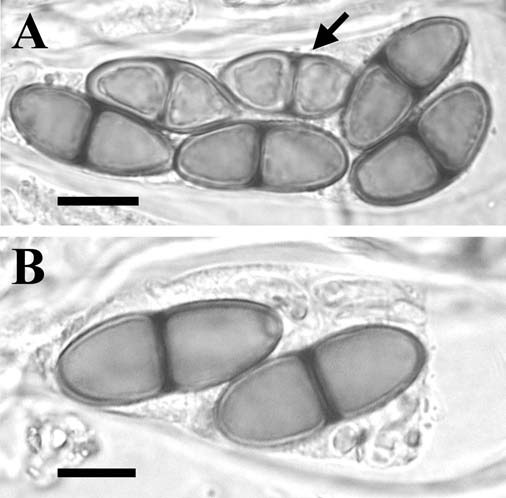Rinodina athallina
|
|
|
|
Family: Physciaceae
|
MB#370092 Type. U.S.A. UTAH. Wayne Co., Ekker's Ranch on dry exposed red sandstone at 6 000 ft, May 1951, S. Flowers s.n. (UPS ‑ holotype!). References. Wetmore (1968 as R. cf. salina), Sheard (1982, 2004 Fig. 63). Description. Thallus light grey to ochraceous, poorly developed, mostly endolithic, binding substrate, or thick, areolate; areoles to 0.85-0.90 mm wide; surface plane or rugose, shining or matt; margin determinate; prothallus lacking; vegetative propagules absent. Apothecia erumpent, usually remaining broadly attached, sometimes becoming narrowly attached, frequent but not contiguous, to 0.60-1.10 mm in diam.; disc black, plane becoming convex and often fissured; thalline margin concolourous with thallus, ca. 0.05 mm wide, entire, quickly becoming excluded; excipular ring absent. Apothecial Anatomy. Thalline exciple 30-80 µm wide laterally; cortex 10-30 µm wide; epinecral layer usually present, 20-30 µm wide; crystals absent from cortex and medulla; cortical cells to 6.0-6.5 µm in diam., not pigmented; algal cells to 12.0-18.0 µm long; thalline exciple absent or 30-60 µm wide below; proper exciple hyaline, 10-25(-50) µm wide laterally, expanding to 40-90 µm wide at periphery; hypothecium hyaline or yellowish, 70-100(-125) µm deep; hymenium not inspersed, 90-150 µm high; paraphyses 2.0-3.0 µm wide, not conglutinate, with apices to 4.0-6.5 µm in diam., not pigmented but immersed in dispersed pigment forming a grey-blue epihymenium, N+ and K+ violet, conglutinate; asci 65-70 x 20-30 µm. Ascospores 8/ascus, Type A development, Beltraminia‑type (Figure 15), (15.5-)22.5-24.5(-31.0) x (7.0-)9.5-10.5(-13.0) µm, average l/b ratio 2.2-2.6, lumina of immature spores sometimes with incipient canals, lumina mostly filling cells from first, narrow swelling at septum in some immature spores, not expanding in KOH, mature spores with relatively dark septum, sometimes slightly curved, finally constricted at the septum; torus absent; walls not ornamented. Pycnidia not seen. Chemistry. Spot tests all negative; secondary metabolites not detected. Substrate and Ecology. Found on calcareous sandstone, recorded at elevations of 1 160-1 830 m. Distribution. A rare North American endemic, distributed on the Colorado Plateau and interior mountains, with outliers in the Cypress Hills, Alberta and the Black Hills, South Dakota. Notes. Rinodina athallina is poorly named since the thallus, although variable, may be quite well developed. The species has previously been compared to R. zwackhiana (Krempelh.) Körb. which also possesses a blue epihymenium (Sheard 1982), but that species has spores belonging to the Bicincta-type. The thalline margin of R. athallina is narrow and may become excluded giving the species a buellioid appearance. The species may be related to R. lobulata (Sheard and Mayrhofer 2002), a primarily corticolous species, that not only has a similar epihymenium pigmentation, but also the same spore structure. The two species are well separated by the significantly smaller spores of R. lobulata and its weaker and more transient epihymenium reaction. The spores have been interpreted here as belonging to the Beltraminia-type but there is also another possibility. The presence of broad lumina canals in the most immature spores and the septum wall pigmentation are reminiscent of the Bischoffii-type of spore. However, the narrowness of the pigmented band and the extremely narrowly ellipsoid shape of the spores would be unprecedented for this spore type. Specimens examined. CANADA. ALBERTA. Cypress Hills, P.A. MacNeil 4140 (CANL). U.S.A. ARIZONA. Apache Co., Ademana? H.E. Hasse (NY). IDAHO. Caribou Co., N Soda Springs, R. Rosentreter 4110 (CANL). SOUTH DAKOTA. Custer Co., Butcher Hill, 15 mi SE Custer, C.M. Wetmore 10185 (MSC). UTAH. Wayne Co., Ekker's Ranch, 1951, S. Flowers (UPS). WYOMING. Sweetwater Co., 3 mi W Rock Springs, C.M. Wetmore 24265 (MIN). Nash, T.H., Ryan, B.D., Gries, C., Bungartz, F., (eds.) 2004. Lichen Flora of the Greater Sonoran Desert Region. Vol 2. Thallus: crustose, thick, areolate, areoles up to 0.85-0.9 mm wide, plane or rugose, or thallus poorly developed and mostly endolithic, binding substrate surface: light gray to ochraceous, shiny or dull; margin: determinate; prothallus: lacking; vegetative propagules: absent Apothecia: erumpent, usually remaining adnate, sometimes becoming sessile, frequent but not contiguous, up to 0.6-1.1 mm in diam. disc: black, plane becoming convex and often fissured thalline margin: concolorous with thallus, c. 0.05 mm wide, entire, quickly becoming excluded; excipular ring: absent thalline exciple: 70-90 µm wide; cortex: 15-20(-30) µm wide; epinecral layer: usually present, 2030 µm wide; cortical cells up to 6-6.5 µm in diam., not pigmented; algal cells: up to 12-18 µm in diam. proper exciple: hyaline,10-25 µm wide laterally, expanding to 40-80 µm wide at periphery hymenium: 90-150 µm tall; paraphyses: 2-3 µm wide, not conglutinate, with apices up to 4-6.5 µm in diam., not pigmented but immersed in dispersed pigment forming a gray-blue epihymenium, N+, K+ violet, conglutinate; hypothecium: hyaline or pale yellow, 70-100(-125) µm thick asci: clavate, 65-70 x 20-30 µm, 8-spored ascospores: brown, 1-septate, narrowly ellipsoid, type A development, Beltraminia-type, (15.5)22.5-24.5(-31) x (7-)9.5-10.5(-13) µm, immature lumina sometimes with incipient canal, lumina mostly filling cells from first, narrow swelling at septum in some immature spores, not expanding in K, mature spores with relatively dark septum, sometimes slightly curved, finally constricted at the septum; torus: absent; walls: not ornamented (Fig. 63) Pycnidia: not seen Spot tests: all negative Secondary metabolites: none detected. Substrate and ecology: found on calcareous sandstone at elevations of 1400-1830 m World distribution: a western North American endemic with only four records known from Arizona to southern Alberta Sonoran distribution: Arizona, locality uncertain (Ademana?) in Apache County. Notes: Rinodina athallina has previously been compared to R. zwackhiana (Krempelh.) Körb. that also possesses a blue epihymenium (Sheard 1982), but that species has spores belonging to the Bicincta-type. Rinodina athallina may be related to R. lobulata (Sheard and Mayrhofer 2002), a primarily corticolous species, that not only has a similar epihymenium pigmentation, but also the same spore structure. The two species are well separated by the significantly smaller spores of R. lobulata and its weaker epihymenium reaction. |





